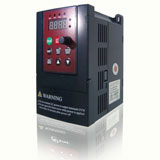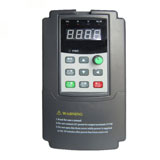Frequency inverter design
Three basic types of inverters offer certain advantages as well as disadvantages depending on your motor application. The new flux vector frequency inverter is also discussed.
While all inverters control the speed of an AC induction motor by varying the motor's supplied voltage and frequency of power, they all do not use the same designs in doing so. There are three major frequency inverter designs commonly used today: pulse width modulation (PWM), current source inverter (CSI), and voltage source inverter (VSI). Recently, the flux vector frequency inverter also has become popular.
Let's compare these technologies.
PWM design
The PWM inverter has become the most commonly used inverter controller because it works well with motors ranging in size from about 1/2 hp to 500 hp. A significant reason for its popularity is that it's highly reliable, affordable and reflects the least amount of harmonics back into its power source. Most units are rated either 230V or 460V, 3-phase, and provide output frequencies from about 2 Hz to 400 Hz. Nearly 100 manufacturers market the PWM controller.
An AC line supply voltage is brought into the input section. From here, the AC voltage passes into a converter section that uses a diode bridge converter and large DC capacitors to create and maintain a stable, fixed DC bus voltage. The DC voltage passes into the inverter section usually furnished with insulated gate bipolar transistors (IGBTs), which regulate both voltage and frequency to the motor to produce a near sine wave like output.
The term "pulse width modulation" explains how each transition of the alternating voltage output is actually a series of short pulses of varying widths. By varying the width of the pulses in each half cycle, the average power produced has a sine-like output. The number of transitions from positive to negative per second determines the actual frequency to the motor.
Switching speeds of the IGBTs in a PWM frequency inverter can range from 2 KHz to 15 KHz. Today's newer PWM designs use power IGBTs, which operate at these higher frequencies. By having more pulses in every half cycle, the motor whine associated with frequency inverter applications is reduced because the motor windings are now oscillating at a frequency beyond the spectrum of human hearing. Also, the current wave shape to the motor is smoothed out as current spikes are removed. Fig. 2 (on page 56) shows the voltage and current waveform outputs from a PWM frequency inverter.
PWMs have the following advantages.
CSI design
The incoming power source to the CSI design is converted to DC voltage in an SCR converter section, which regulates the incoming power and produces a variable DC bus voltage. This voltage is regulated by the firing of the SCRs as needed to maintain the proper volt/hertz ratio. SCRs are also used in the inverter section to produce the variable frequency output to the motor. CSI frequency inverters are inherently current regulating and require a large internal inductor to operate, as well as a motor load.
CSIs have the following advantages.
VSI design
The VSI frequency inverter is very similar to a CSI frequency inverter in that it also uses an SCR converter section to regulate DC bus voltage. Its inverter section produces a six-step output, but is not a current regulator like the CSI frequency inverter. This frequency inverter is considered a voltage regulator and uses transistors, SCRs or gate turn off thyristors (GTOs) to generate an adjustable frequency output to the motor.
VSIs have the following advantages.
TERMS TO KNOW
Cogging: Pulsating symptom of a motor while operating at a very low frequency, usually 2 to 6 Hz. Shaft of motor jerks in a rotational manner. The term "cogging" comes from gear cogs.
Non-regenerative: The inability of a frequency inverter to regenerate, or reverse, the power flow back from the motor through the frequency inverter.
PWM frequency inverter technology is still considered new and is continuously being refined with new power switching devices and smart 32-bit microprocessors. Frequency inverters have always been limited to "normal torque" applications while high torque, low rpm applications have been the domain of DC drives. This has changed recently with the introduction of a new breed of PWM frequency inverter, the flux vector frequency inverter.
Flux vector frequency inverters use a method of controlling torque similar to that of DC drive systems, including wide speed control range with quick response. Flux vector frequency inverters have the same power section as all PWM frequency inverters, but use a sophisticated closed loop control from the motor to the frequency inverter's microprocessor. The motor's rotor position and speed is monitored in real time via a resolver or digital encoder to determine and control the motor's actual speed, torque, and power produced.
By controlling the inverter section in response to actual load conditions at the motor in a real time mode, superior torque control can be obtained. The personality of the motor must be programmed into or learned by the frequency inverter in order for it to run the vector control algorithms. In most cases, special motors are required due to the torque demands expected of the motor.
The following are advantages of this new frequency inverter technology.
While all inverters control the speed of an AC induction motor by varying the motor's supplied voltage and frequency of power, they all do not use the same designs in doing so. There are three major frequency inverter designs commonly used today: pulse width modulation (PWM), current source inverter (CSI), and voltage source inverter (VSI). Recently, the flux vector frequency inverter also has become popular.
Let's compare these technologies.
PWM design
The PWM inverter has become the most commonly used inverter controller because it works well with motors ranging in size from about 1/2 hp to 500 hp. A significant reason for its popularity is that it's highly reliable, affordable and reflects the least amount of harmonics back into its power source. Most units are rated either 230V or 460V, 3-phase, and provide output frequencies from about 2 Hz to 400 Hz. Nearly 100 manufacturers market the PWM controller.
An AC line supply voltage is brought into the input section. From here, the AC voltage passes into a converter section that uses a diode bridge converter and large DC capacitors to create and maintain a stable, fixed DC bus voltage. The DC voltage passes into the inverter section usually furnished with insulated gate bipolar transistors (IGBTs), which regulate both voltage and frequency to the motor to produce a near sine wave like output.
The term "pulse width modulation" explains how each transition of the alternating voltage output is actually a series of short pulses of varying widths. By varying the width of the pulses in each half cycle, the average power produced has a sine-like output. The number of transitions from positive to negative per second determines the actual frequency to the motor.
Switching speeds of the IGBTs in a PWM frequency inverter can range from 2 KHz to 15 KHz. Today's newer PWM designs use power IGBTs, which operate at these higher frequencies. By having more pulses in every half cycle, the motor whine associated with frequency inverter applications is reduced because the motor windings are now oscillating at a frequency beyond the spectrum of human hearing. Also, the current wave shape to the motor is smoothed out as current spikes are removed. Fig. 2 (on page 56) shows the voltage and current waveform outputs from a PWM frequency inverter.
PWMs have the following advantages.
- Excellent input power factor due to fixed DC bus voltage.
- No motor cogging normally found with six-step inverters.
- Highest efficiencies: 92% to 96%.
- Compatibility with multimotor applications.
- Ability to ride through a 3 to 5 Hz power loss.
- Lower initial cost.
- Motor heating and insulation breakdown in some applications due to high frequency switching of transistors.
- Non-regenerative operation.
- Line-side power harmonics (depending on the application and size of the frequency inverter).
CSI design
The incoming power source to the CSI design is converted to DC voltage in an SCR converter section, which regulates the incoming power and produces a variable DC bus voltage. This voltage is regulated by the firing of the SCRs as needed to maintain the proper volt/hertz ratio. SCRs are also used in the inverter section to produce the variable frequency output to the motor. CSI frequency inverters are inherently current regulating and require a large internal inductor to operate, as well as a motor load.
CSIs have the following advantages.
- Reliability due to inherent current limiting operation.
- Regenerative power capability.
- Simple circuitry.
- Large power harmonic generation back into power source.
- Cogging below 6 Hz due to square wave output.
- Use of large and costly inductor.
- HV spikes to motor windings.
- Load dependent; poor for multimotor applications.
- Poor input power factor due to SCR converter section.
VSI design
The VSI frequency inverter is very similar to a CSI frequency inverter in that it also uses an SCR converter section to regulate DC bus voltage. Its inverter section produces a six-step output, but is not a current regulator like the CSI frequency inverter. This frequency inverter is considered a voltage regulator and uses transistors, SCRs or gate turn off thyristors (GTOs) to generate an adjustable frequency output to the motor.
VSIs have the following advantages.
TERMS TO KNOW
Cogging: Pulsating symptom of a motor while operating at a very low frequency, usually 2 to 6 Hz. Shaft of motor jerks in a rotational manner. The term "cogging" comes from gear cogs.
Non-regenerative: The inability of a frequency inverter to regenerate, or reverse, the power flow back from the motor through the frequency inverter.
- Basic simplicity in design.
- Applicable to multimotor operations.
- Operation not load dependent.
- Large power harmonic generation back into the power source.
- Poor input power factor due to SCR converter section.
- Cogging below 6 Hz due to square wave output.
- Non-regenerative operation.
PWM frequency inverter technology is still considered new and is continuously being refined with new power switching devices and smart 32-bit microprocessors. Frequency inverters have always been limited to "normal torque" applications while high torque, low rpm applications have been the domain of DC drives. This has changed recently with the introduction of a new breed of PWM frequency inverter, the flux vector frequency inverter.
Flux vector frequency inverters use a method of controlling torque similar to that of DC drive systems, including wide speed control range with quick response. Flux vector frequency inverters have the same power section as all PWM frequency inverters, but use a sophisticated closed loop control from the motor to the frequency inverter's microprocessor. The motor's rotor position and speed is monitored in real time via a resolver or digital encoder to determine and control the motor's actual speed, torque, and power produced.
By controlling the inverter section in response to actual load conditions at the motor in a real time mode, superior torque control can be obtained. The personality of the motor must be programmed into or learned by the frequency inverter in order for it to run the vector control algorithms. In most cases, special motors are required due to the torque demands expected of the motor.
The following are advantages of this new frequency inverter technology.
- Excellent control of motor speed, torque, and power.
- Quick response to changes in load, speed, and torque commands.
- Ability to provide 100% rated torque at 0 speed.
- Lower maintenance cost as compared to DC motors and frequency inverters.
- Higher initial cost as compared to standard PWM frequency inverters.
- Requires special motor in most cases.
- Frequency inverter setup parameters are complex.

 High quality frequency inverters for electric motor speed controls in energy-saving solutions.
High quality frequency inverters for electric motor speed controls in energy-saving solutions.

